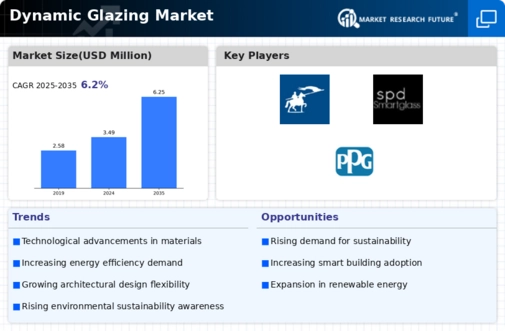Market Share
Dynamic Glazing Market Share Analysis
In the rapidly advancing Dynamic Glazing Market, companies employ a variety of strategies to secure their market share and establish a strong positioning. One primary strategy involves product differentiation. Dynamic glazing manufacturers focus on offering a diverse range of products with different features, technologies, and applications to cater to the specific needs of various industries and projects. By providing options such as electrochromic, thermochromic, and photochromic dynamic glazing solutions, companies can target different market segments and appeal to a broad spectrum of customers with varying requirements for energy efficiency, daylight control, and aesthetic preferences. This strategy of product differentiation enables companies to stand out in the market by offering tailored solutions that meet specific architectural, environmental, and performance needs.
In this type of dynamic glazing, the occupant has no control over the tint level of the glass. On the basis of end users, dynamic glazing market is being segmented as residential, commercial, transportation and others. Among them,, the commercial segment is expected to grow the highest with its increasing applications in marine, aviation, hospitals, and other commercial building applications. These also help in eliminating the need for extensive use of curtains, thereby driving the growth of the market.
Pricing strategy is another critical aspect of market share positioning in the Dynamic Glazing Market. Companies often adopt different pricing strategies based on factors such as product performance, technology sophistication, and target market segments. Some companies may opt for a premium pricing strategy, positioning their dynamic glazing products as high-quality, advanced solutions targeted at customers who prioritize energy efficiency and are willing to pay a premium price for superior performance and comfort. Conversely, other companies may choose a value-based pricing strategy, offering competitive prices to gain market share rapidly, especially in price-sensitive market segments such as commercial buildings or residential construction. Additionally, promotional pricing tactics such as discounts, rebates, or financing options are also utilized to attract customers and increase market share.
Distribution channels play a crucial role in market share positioning for dynamic glazing manufacturers. Companies need to ensure their products are readily available to customers through efficient distribution channels. This involves partnering with architects, designers, glaziers, and building contractors with a wide reach and strong distribution networks. Additionally, companies may also invest in their distribution infrastructure, including regional warehouses and logistics facilities strategically located to ensure timely delivery of products to customers across different geographic regions. By optimizing their distribution channels, companies can enhance their market presence and gain a competitive edge over rivals.
Branding and marketing strategies are instrumental in establishing a strong market share positioning in the Dynamic Glazing Market. Building a reputable brand image helps companies differentiate themselves from competitors and influence customer perceptions positively. Dynamic glazing manufacturers invest in branding initiatives that highlight the unique features, benefits, and applications of their products, as well as their commitment to sustainability and innovation. This could include obtaining certifications related to product performance and environmental standards, showcasing case studies of successful projects using dynamic glazing, and engaging in educational initiatives to raise awareness about the benefits of using dynamic glazing in building design. Additionally, effective marketing strategies such as targeted advertising, digital marketing campaigns, and participation in industry events and trade shows help companies increase brand visibility and reach a wider audience, ultimately driving market share growth.
Innovation and product development are also crucial components of market share positioning strategies in the Dynamic Glazing Market. Companies strive to differentiate themselves by continuously innovating and introducing new dynamic glazing solutions with enhanced properties and performance characteristics. This could involve developing advanced materials and coatings for improved solar control, glare reduction, and thermal insulation, or integrating smart technologies for automated control and optimization of daylighting and energy efficiency. By staying ahead of the curve in terms of product innovation and technological advancements, companies can capture market share by offering cutting-edge solutions that meet the evolving needs of customers in various industries, including commercial real estate, healthcare, education, and hospitality.
Strategic partnerships and collaborations are another avenue for market share positioning in the Dynamic Glazing Market. Collaborating with architects, designers, building owners, and industry partners allows companies to showcase their products in real-world applications and gain credibility. Strategic partnerships with glass manufacturers, technology providers, and research institutions can also help companies gain access to new materials, processes, and innovations. By leveraging the strengths of partners and collaborating on joint marketing efforts, companies can strengthen their market share positioning and achieve sustainable growth in the competitive Dynamic Glazing Market.






Leave a Comment